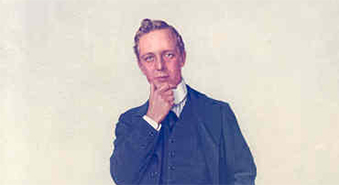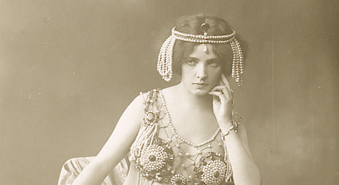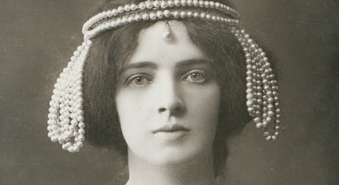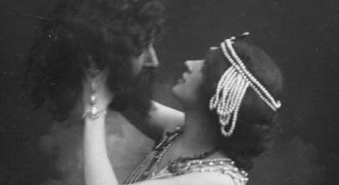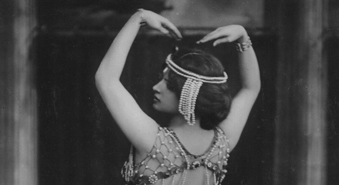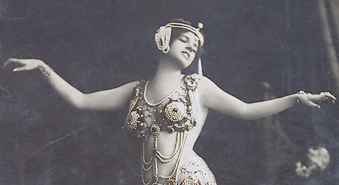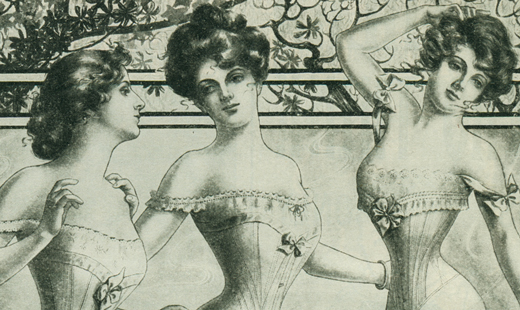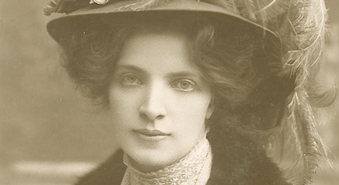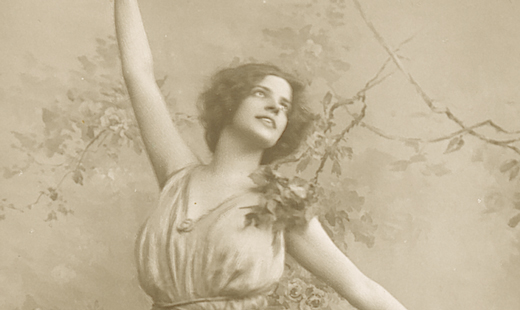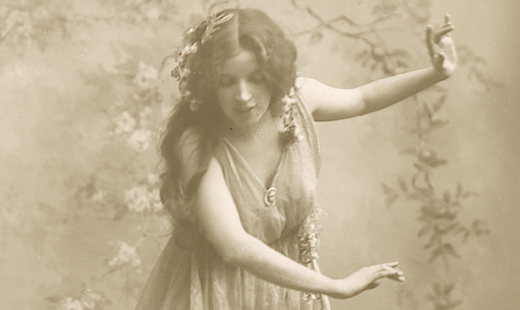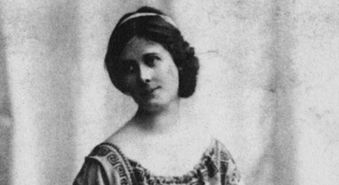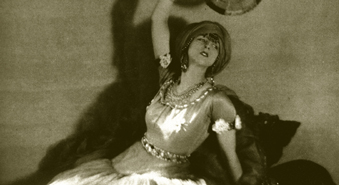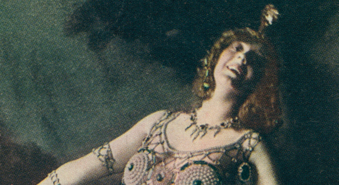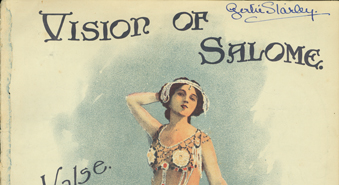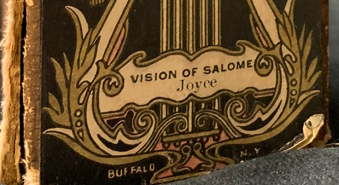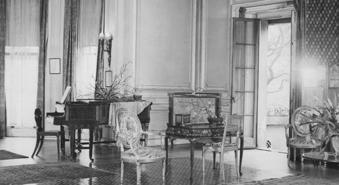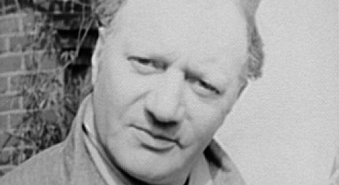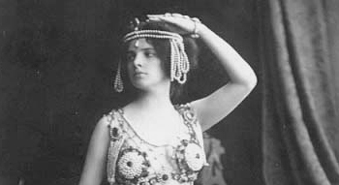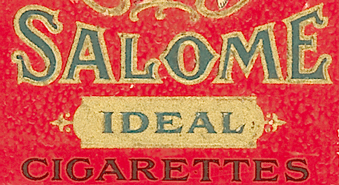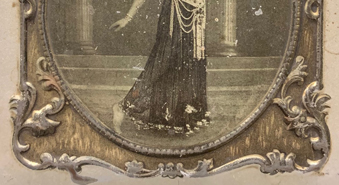
Presents
Maud Allan - An Edwardian Sensation
Conquest of London
The Palace Theatre of Varieties
On March 6, 1908, an enchanting performer appeared before a private audience at the Palace – London’s leading variety theatre.
Maud arrived in London in February 1908 for a two-week engagement at the Palace Theatre. She called on Alfred Butt who was London’s leading entertainment manager. Amusingly, Maud first mistook Butt for the theatre’s doorman. He chose not to add Maud Allan to the Palace program in a routine fashion and instead presented her as one of his “discoveries” in a private matinee recital. This was instrumental to Maud’s success, since it allowed her to attract more attention than being debuted among a dozen or more performers in a variety program, thus expediting her success.
She captivated spectators with the expressiveness of her face and the lyricism of her movement. She had striking features with her deeply recessed and incredibly wide-spaced eyes staring out beneath a broad forehead. Most shocking of all was the daring costume she wore with total confidence.
A rebellious garment
In an era when restrictive corsets, high-boned collars and conservative, floor-length dresses were considered acceptable attire, dancer Maud Allan glimmered under the stage lights with undeniable sexuality – a topic far too racy to be discussed openly by the Edwardian public. She interpreted Marcel Rémy’s musical rendition of The Vision of Salomé in bare feet, painted toenails and a sparkling brassiere designed to emphasize an ample bosom. Overlaying her soft torso was a layered net of pearls that faded into a bejewelled transparent skirt giving the impression that the provocative artist was dancing nude.
Fashions in the Edwardian Era exploited the curves of an elaborately corseted figure. Women tightly laced their bodies in order to achieve a “faultless figure,” the exaggerated ‘S’ shape associated with the era. These advertisements offer insight into the era’s tastes and style.
An increased literacy in the middle class gave women wider access to information. Numerous new magazines appealed to their tastes and helped define femininity, while the inventions of the typewriter and telephone offered women increased employment opportunities. So, too, did the rapid expansion of the school system and the emergence of the new profession of nursing.
The picture hat, like the one worn here by Maud Allan, was a popular style in the late-18th century that became fashionable again near the end of the 19th century, popularized through images of Gibson Girls in the United States and Canada, and the Gaiety Girls of the London Theatre. These hats were large, with a wide brim, heavily ornate, and designed to perch on top of the lavish hairstyles popular during this era.
Whether deliberate or by coincidence, the costume, in combination with Maud’s position in society and her vocation as a dancer, challenged the Edwardian attitude that suggested that a woman’s role was raising children within the home. It also defied the era’s fashion and tastes through the abandonment of restrictive corsets, high-boned collars, floor-length dresses, stockings, and shoes. Though Maud’s costume made an impact on London fashion, Maud took care to dress with impeccable taste off stage. She soon became a prominent figure in the world of fashion.
Grecian Inspiration
Two days after the private matinee recital at the Palace Theatre, Maud Allan made her public debut and became an overnight sensation. London critics praised her for the “new” style of dance, which she called “musically impressionistic mood settings.” She claimed that these musical interpretations were unique and inimitable since her movements were deliberately spontaneous.
Having never received any formal training, Maud learned to dance by studying and imitating the poses found on ancient Greek vases and reliefs. In her autobiography, she describes this experimentation by stating that “It was not sufficient to master a pose, and rest content with that; nothing was more difficult than to weave harmonious, musical connection between the different poses so that there should be no break, so that there should be nothing to mar the rhythmic sense of continuous harmonious expression. It was my endeavour to disperse rhythm harmoniously to the tips of fingers and toes.”
The likelihood is that Allan’s dance repertoire was not unique. The movement that would evolve into modern dance in the next generation was well underway with established contemporaries such as Loie Fuller, Isadora Duncan and, later, Ruth St. Denis – all Americans working in Europe. Along with Maud Allan, these radical dancers sought greater freedom of movement and expression. They rejected ballet’s restrictive lines and prescribed steps by pioneering new movement practices, and they reformed costuming by abandoning corsets, stockings, and pointe shoes. Their rebellion against existing dance conventions included using short concert pieces by composers such as Brahms, Chopin, and Mendelssohn instead of traditional ballet music, though there is evidence that Allan also interpreted excerpts of Tchaikovsky’s The Nutcracker Suite. Both Duncan and Allan had danced briefly for Fuller, and newspaper coverage reveals the rivalry that existed between them where Duncan implicates Allan as her imitator. Nevertheless, by 1908, Maud Allan was the most notorious of the forerunners of modern dance.
Of the forerunners of modern dance, Allan is the most obscured from history likely because she had no disciples and there is little record of her actual movement. Fuller is famous for her developments in lighting technology and her use of voluminous billowing silk. Duncan was deeply inspired by ancient Greek imagery and nature in her movement. St. Denis was inspired by Eastern religion and incorporated yoga in her practice and in her teaching with Ted Shawn at their Denishawn School in Los Angeles. Though not explicitly suffragettes, these women embodied the philosophy of first-wave feminism through their breaks with social convention at the fin de siècle: being ambitious career women with financial independence and not living under the restrictions of their father’s or husband’s homes; making no secret of taking lovers out of wedlock; removing their corsets, stockings, and shoes to perform; living a life solely determined by their own aspirations.
Maud Allan made her professional dancing debut on December 24, 1903 at the Theatre Hall of Vienna’s Conservatory of Music presenting herself as Miss Maudie Gwendolyn Allan. The program opened with Mendelssohn’s Spring Song, and featured Chopin’s Marche funèbre, Schubert’s Ava Maria and Rubinstein’s Valse caprice. Many of these dances later became favourites of London audiences, but she became a sensation with the performance of her controversial Vision of Salomé, which triggered a series of imitators and the "Salomania" phenomenon. Publicity postcards were frequently sold at performances.
Maud danced to Marcel Rémy’s musical rendition of the Vision of Salomé, but her interpretation inspired various dance and musical imitations by other dancers and composers during the early twentieth century, such as those by dancer Gertrude Hoffman and composer Archibald Joyce, known as the “waltz king” of Edwardian London.
During her engagement at the Palace Theatre, Maud broke all box-office records earning about £250 a week. The sensational dancer instantaneously went from rags to riches, and, by 1910, she had moved into the West Wing of Holford House, a mammoth residence overlooking London’s Regent’s Park. Maud was quickly accepted by London society for her charm and elegance. One of her more consequential contacts was Herbert Asquith who had become Prime Minister of a Liberal government in April 1908. His wife, Margot Asquith, quickly became a friend of Maud Allan; their relationship was rumoured to also be romantic in nature though no evidence of this was ever produced. As a master of manipulation, Maud convinced her wealthy friend to take on the expensive lease. Allan also persuaded Mrs. Asquith to pay for the installation of floor-to-ceiling mirrors in her studio. Over the years, Maud changed the furniture and added a statue of herself. The Maud Allan statue in the bow window is believed to have been created by British sculptor, Jacob Epstein, who helped pioneer modern sculpture.
Maud Allan‘s controversial Vision of Salomé became all the rage triggering the “Salomania” phenomenon. Not only did collectors’ items start springing up in gift shops and theatres, but women also embraced more provocative clothing choices inspired by Allan’s costume. Maud Allan’s scandalous costume not only led to her fame as the Salomé dancer, but it also affected the style choices of various fashion-conscious women in London. Some adopted sandals, while others went about their daily routine barelegged and barefooted. Even costume jewelers looked to Maud for inspiration. Their best seller was a large string of beads worked into a shaped design and adorned with three immense jewel-covered bosses, two of which were worn as breastplates. The popularity of sequins gave way to bead fringes and bead trimmings.


